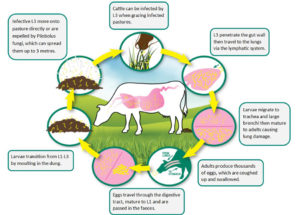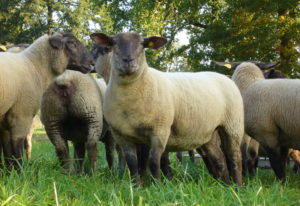Are you ready for the grazing season?

Lungworm
- Lungworm (or Husk) is caused by the parasitic worm Dictyocaulus viviparous which can infect cattle of all ages and breeds which have not been able to build immunity through natural exposure or vaccination.
- Lungworm is now well established on grazing land across the UK which means that planning lungworm control strategies against this widespread disease is important for all farmers.
- Outbreaks of lungworm can be unpredictable and so vaccination before turnout protects a herd from walking into a potential minefield.
Lungworm outbreaks are seasonal with the highest percentage of diagnoses being reported in late summer and autumn.
Symptoms include:
- Reduced growth rates
- Loss of appetite
- Reduced milk yields
- Increased risk of pneumonia/ bronchitis (coughing/ open mouth breathing)
- Death
- The economic impact of this has been calculated at £50-£100 per beef cow and £140 per dairy cow
Prevention
Cattle can produce an immune response to lungworm larvae and adult worms. This immunity can wane after a few months unless cattle are exposed to low-level contamination on the pasture.
Vaccination is the most predictable method of building herd immunity to protect against lungworm.
Cattle can be vaccinated for lungworm by giving an oral vaccine (2 doses 4 weeks apart) containing irradiated lungworm larvae (L3) which stimulate immunity. Cattle need to be turned out onto low-level infected pasture no sooner than 2 weeks after completing the vaccination course which allows them to boost their immunity naturally.
Vaccination provides a solid base of immunity at the start of the season, which is maintained in a controlled way through grazing low-level contaminated pasture.
If you would like to discuss your lungworm strategy on your farm, please get in touch and one of our vets will be happy to help!

Frozen sheep semen
The purchase of frozen sheep semen allows expensive rams to be used to increase the rate of genetic gain and is more cost-effective than purchasing an expensive ram.
Rams anywhere in the country or the world can be used!
The use of frozen sheep semen reduces the reliance on bought in rams therefore reducing the possibility for disease transmission and aids in the management of closed flocks. Rams can be shared over a large geographical area without the need for transport.
The process of the artificial insemination of sheep
AI in sheep is usually performed laparoscopically.
Step 1 – Ewes are synchronised with hormones to ensure they come into season at the same time.
Step 2 – They are starved overnight and on AI day they are loaded into crates.
Step 3 – The vet uses a laparoscope to visualise the uterus through the abdominal wall and injects semen directly into each uterine horn.
Collection of sheep semen
Semen can be collected from your own rams on the day of AI. This is assessed under the microscope to ensure it is of sufficient quality. This can then be diluted and used to inseminate up to 50 ewes from one tup.
It is important to have a backup plan if your chosen tup isn’t good enough – either another tup or frozen semen.
Conception rates for frozen AI are usually 65% + and for fresh AI greater than 70%.
Sheep Embryo Transfer
Embryo transfer allows the production of multiple offspring from elite females within your flock.
Embryo transfer is the process by which fertilised embryos are flushed (removed) from a donor ewe and then transplanted into suitably synchronised recipient ewes to establish a surrogate pregnancy.
What is the process of embryo transfer in sheep?
The donor ewe is treated with hormones so that she produces more eggs than usual at a synchronised mating.
This programme usually lasts 20 days with the ewe being artificially inseminated on day 14, and the six-day-old embryos being flushed from her on day 20.
Flushing is a surgical procedure done through a small abdominal incision under general anaesthetic.
Embryos are then either transferred into prepared surrogate recipient ewes in a process similar to laparoscopic AI, or frozen for future use.
Why freeze sheep embryos?
The ability to freeze embryos means flushing can take place out of the breeding season and a single ewe can be flushed multiple times. Frozen embryos can also be purchased from other breeders and implanted into recipient ewes. Recipient ewes are chosen for their mothering ability and likelihood of being able to give birth naturally.
Embryo transfer is usually done on-site at Barnard Castle, but could be done on-farm if facilities were suitable and there are sufficient numbers of donors
If you are interested in these advanced sheep breeding services please call for more information and advice on 01833 695695.
